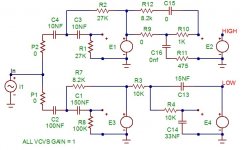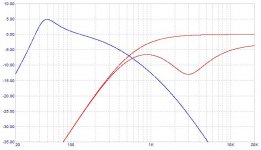My current crossover has op-amp buffers and I have set up impedance balanced outputs by adding a matching resistor on the output ground. I see that this circuit has 100 ohm resistors on the outputs. I wonder if the same thing could be done with these buffers to create a balanced output.
3-way balance ASP for LXmini/+2/LXstudio
Nelsons assembled balanced 3-way ASP sets are shipping...
See https://www.magiclx521.com/news
Nelsons assembled balanced 3-way ASP sets are shipping...
See https://www.magiclx521.com/news
Looks like that may be hard to measure. Would your example be useful as an estimate for these Jfets to get in the ballpark? Perhaps it is not worth doing. What do you think?Yes, but you need to add the output impedance of the Jfet to the
value of the 100 ohms. If you know the transconductance of the Jfet, then you can invert it for that value.
Example, 40 mS transconductance gives 1/0.040 = 25 ohms.
Thanks for your reply.
Last edited by a moderator:
If you need to bypass a capacitor, draw a wire around it.
If you just want it gone, give it a zero value.
If you need the resistor to be open, give it a 100 Meg value.
If you need it shorted, give it a zero value.
Feel free to experiment with the sims - copy and paste, change values,
draw wires, add new test points, and so on.
If you just want it gone, give it a zero value.
If you need the resistor to be open, give it a 100 Meg value.
If you need it shorted, give it a zero value.
Feel free to experiment with the sims - copy and paste, change values,
draw wires, add new test points, and so on.
Two sets of options: You can bypass a capacitor with a wire or replace itIf c15 and c16 are “ gone” how does the signal reach the high out? Please clarify.
with a wire if you want signal to continue to go through. When you don't
want signal going through, for example when it is a low pass to ground
filter, you set it at zero or delete it altogether.
Last edited by a moderator:
OK, up and running. picking DIY will take you to a page where you have the address to download MicroCap demo version and LTSpice. There is a link to a zip folder with Microcap LXmini sim that will run and which you can modify and fool around with.firstwatt link does not work.
More to come.

Last edited by a moderator:
Xover finished making music...first impressions
Because I had been using a minidsphd 2x4 set at 100hz at a 12db slope, the same parameters I set in the lx-mini, I haven’t seen the necessity of even changing the volume setting in the Crown amp. powering the “subwoofers”. I have reversed their polarity though, because this was done in the digital domain in the minidsp. Right of the bat, the presentation is fuller sounding and it is more transparent and smoother. The mini was a little “threadbare” in the highs compared to this one. I notice that bass might go deeper. I don’t think there might be too much “break-in” here. The mini is really a bargain and a very good tool to experiment and to set various parameters and really sounds pretty good also. My main speakers are the Spatials M4 powered by a FW F4, ba-3 linestage and a pair of diy Ripole subwoofers. One thing to bring across is that making your main amp reproduce frequencies from a 100 hz up really makes the system sound more “effortless” And thanks Nelson for making this available.
Because I had been using a minidsphd 2x4 set at 100hz at a 12db slope, the same parameters I set in the lx-mini, I haven’t seen the necessity of even changing the volume setting in the Crown amp. powering the “subwoofers”. I have reversed their polarity though, because this was done in the digital domain in the minidsp. Right of the bat, the presentation is fuller sounding and it is more transparent and smoother. The mini was a little “threadbare” in the highs compared to this one. I notice that bass might go deeper. I don’t think there might be too much “break-in” here. The mini is really a bargain and a very good tool to experiment and to set various parameters and really sounds pretty good also. My main speakers are the Spatials M4 powered by a FW F4, ba-3 linestage and a pair of diy Ripole subwoofers. One thing to bring across is that making your main amp reproduce frequencies from a 100 hz up really makes the system sound more “effortless” And thanks Nelson for making this available.
Last edited by a moderator:
Is it possible to get this sim file in a MC9 compatible version?
Scrub that, sussed it...

- Home
- Amplifiers
- Pass Labs
- LX-mini Crossover Article

